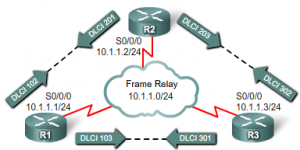Before a Cisco router is able to transmit data over Frame Relay, it needs to know which local DLCI maps to the Layer 3 address of the remote destination. Cisco routers support all Network layer protocols over Frame Relay, such as IP, IPX, and AppleTalk. This address-to-DLCI mapping can be accomplished either by static or dynamic mapping.
The Frame Relay service provider assigns DLCI numbers. Usually, DLCIs 0 to 15 and 1008 to 1023 are reserved for special purposes. Therefore, service providers typically assign DLCIs in the range of 16 to 1007.
To map between a next hop protocol address and DLCI destination address, use this command:
1 | frame-relay map protocol protocol-address dlci [broadcast] [ietf] [cisco] |
Use the keyword ietf when connecting to a non-Cisco router.
You can greatly simplify the configuration for the Open Shortest Path First (OSPF) protocol by adding the optional broadcast keyword when doing this task.
1 2 3 4 5 6 | R1 (config) # interface s0/0/0 R1 (config-if) # ip address 10.1.1.1 255.255.255.0 R1 (config-if) # encapsulation frame-relay R1 (config-if) # no frame-relay inverse-arp R1 (config-if) # frame-relay map ip 10.1.1.2 102 broadcast cisco R1 (config-if) # no shut |
1 2 3 4 5 | R1 (config) # interface s0/0/0 R1 (config-if) # ip address 10.1.1.1 255.255.255.252 R1 (config-if) # encapsulation frame-relay R1 (config-if) # bandwidth 64 R1 (config-if) # frame relay map ip 10.1.1.2 102 broadcast |
1 | R1 (config-if) # frame-relay lmi-type ansi |
Basically, the LMI is a keepalive mechanism that provides status information about Frame Relay connections between the router (DTE) and the Frame Relay switch (DCE).
US Bandwidth:
E0 64 kbit/s
E1 2.048 Mbit/s
E2 8.448 Mbit/s
E3 34.368 Mbit/s
E4 139.264 Mbit/s
E5 564.992 Mbit/s
T1 1,536 Kb/s UP and DOWN



Leave a Reply